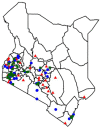" They Just Tell Me to Abstain:" Variable Access to and Uptake of Sexual and Reproductive Health Services Among Adolescents Living With HIV in Kenya
- PMID: 36303968
- PMCID: PMC9580776
- DOI: 10.3389/frph.2021.644832
" They Just Tell Me to Abstain:" Variable Access to and Uptake of Sexual and Reproductive Health Services Among Adolescents Living With HIV in Kenya
Abstract
Background: To improve holistic care for adolescents living with HIV (ALHIV), including integration of sexual and reproductive health services (SRHS), the Kenya Ministry of Health implemented an adolescent package of care (APOC). To inform optimized SRH service delivery, we sought to understand the experiences with SRHS for ALHIV, their primary caregivers, and health care workers (HCWs) following APOC implementation. Methods: We completed a mixed methods evaluation to characterize SRHS provided and personal experiences with access and uptake using surveys conducted with facility managers from 102 randomly selected large HIV treatment facilities throughout Kenya. Among a subset of 4 APOC-trained facilities in a high burden county, we conducted in-depth interviews (IDIs) with 40 ALHIV and 40 caregivers of ALHIV, and 4 focus group discussions (FGDs) with HCWs. Qualitative data was analyzed using thematic analysis. Facility survey data was analyzed using descriptive statistics. Results: Of 102 surveyed facilities, only 56% reported training in APOC and 12% reported receiving additional adolescent-related SRHS training outside of APOC. Frequency of condom provision to ALHIV varied, with 65% of facilities providing condoms daily and 11% never providing condoms to ALHIV. Family planning (FP) was provided to ALHIV daily in 60% of facilities, whereas 14% of facilities reported not providing any FP services to ALHIV. Screening and treatment for STIs for adolescents were provided at all clinics, with 67% providing STI services daily. Three key themes emerged characterizing experiences with adolescent SRHS access and uptake: (1) HCWs were the preferred source for SRH information, (2) greater adolescent autonomy was a facilitator of SRH discussions with HCWs, and (3) ALHIV had variable access to and limited uptake of SRHS within APOC-trained health facilities. The primary SRHS reported available to ALHIV were abstinence and condom use education. There was variable access to FP, condoms, pregnancy and STI testing, and partner services. Adolescents reported limited utilization of SRHS beyond education. Conclusions: Our results indicate a gap in SRHS offered within APOC trained facilities and highlight the importance of adolescent autonomy when providing SRHS and further HCW training to improve SRHS integration within HIV care for ALHIV.
Keywords: adolescent HIV; adolescent sexual and reproductive health; adolescents; implementation science; mixed methods.
Copyright © 2021 Lawrence, Moraa, Wilson, Mutisya, Neary, Kinuthia, Itindi, Nyaboe, Muhenje, Chen, Singa, McGrath, Ngugi, Kohler, Roxby, Katana, Ng'ang'a, John-Stewart and Beima-Sofie.
Conflict of interest statement
The authors declare that the research was conducted in the absence of any commercial or financial relationships that could be construed as a potential conflict of interest.
Figures

References
-
- UNAIDS . Graphs. (2017). Available online at: http://aidsinfo.unaids.org (accessed September 11, 2018).
-
- WHO . Adolescent Health. (2018). Available online at: http://www.who.int/topics/adolescent_health/en/ (accessed July 28, 2018).
-
- WHO . Adolescents Falling Through Gaps in HIV Services. (2013). Available online at: http://www.who.int/mediacentre/news/releases/2013/hiv-adolescents-201311... (accessed June 28, 2019).
-
- Chandra-Mouli V, Chatterjee S, Bose K. Do efforts to standardize, assess and improve the quality of health service provision to adolescents by government-run health services in low and middle income countries, lead to improvements in service-quality and service-utilization by adolescents? Reprod Health. (2016) 13:10. 10.1186/s12978-015-0111-y - DOI - PMC - PubMed
LinkOut - more resources
Full Text Sources
Miscellaneous

